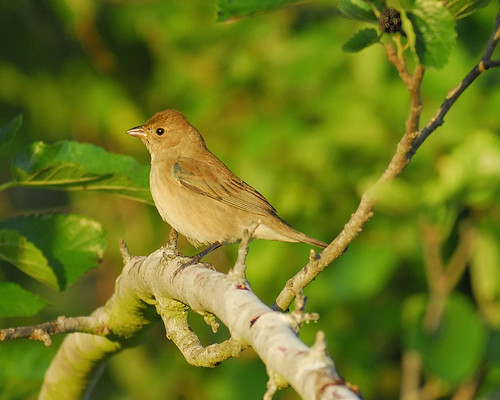tags: Indigo Bunting, Passerina cyanea, birds, mystery bird, bird ID quiz
[Mystery bird] Female Indigo Bunting, Passerina cyanea, photographed at the east end of Galveston Island, Texas. [I will identify this bird for you tomorrow]
Image: Joseph Kennedy, 16 April 2007 [larger view].
Nikon D200, Kowa 883 telescope TSN-PZ camera eyepiece 1/125s f/8.0 at 1000.0mm iso400.
Please name at least one field mark that supports your identification.
Rick Wright, Managing Director of WINGS Birding Tours Worldwide, writes:
Hard to image anything plainer. But that very plainness -- plus the odd hint of greenish-blue at the bend of the wing -- identifies this bird as surely as any set of lavish field marks would.
We're looking at a fairly small bird, with a short tail, medium-short wing, and a heavy, "seed-eating" bill. Apart from the color at the bend of the wing, the only plumage "field marks" are the diffuse streaks on the breast and flanks. The shape says Passerina bunting, and the cold, gray-brown color and lack of conspicuously contrasting plumage characters says Indigo.
A Lazuli Bunting generally shows narrow, well-defined whitish wingbars; the underparts would be unstreaked, and the breast might show a warm cinnamon tone, continuing onto the throat. Varied Bunting is also unstreaked, and generally noticeably darker, especially on the underparts and tail; while the culmen is straight on this bird, it is obviously curved on Varied Bunting, making the latter species look fatter-billed from most angles.
Famously, Indigo and Lazuli Buntings interbreed freely on the Great Plains, and many male hybrids and introgressants are readily identified by their combination of plumage characters. Female-plumaged birds are much more difficult, largely because the differences separating "pure" examples of each are so slight. I have never identified with certainty a brown Passerina hybrid, though one would assume that they are as frequent as male birds showing mixed characters. So if I were to obey my conscience, I'd call this a brown Passerina displaying no obvious indications of hybrid origin -- but to tell the truth, I don't think I'd bother to be quite that punctilious. Indigo Bunting it is!


I'm going to call that a scarlet tanager. I'm going mainly by the beak, which seems just a tad too long and narrow to be any of the various drab seed-eaters in the running, and too short and stubby to be one of the other wingbar-less tanagers (like summer tanager).
That hint of color at the leading edge of the folded wing is making me scratch my head; I'm not sure what I'm seeing there. And overall, the plumage of this bird doesn't exactly look like the scarlet tanager illustrations in Sibley; I feel like I'm seeing more brown, and less green, than I want to see. And the bird's silhouette is somewhat problematic, too; there are other birds that this bird's posture and general shape reminds me of more.
But plumage in tanagers is variable, and the color in this image could be partly the result of the magic-hour lighting. And birds can change their shape and posture, and do, seemingly just to mess with my head, sometimes. And I keep coming back to the beak; no matter how convincing an impression of a thrush, or a sparrow, or a bunting, or I don't know what else, this bird does, it still has that beak.
Female Indigo Bunting (Passerina cyanea).
Hefty bunting bill, warm chocolate-brown plumage above, paler beneath, touch of blue at the bend of the wing.
Sigh. Yeah, I see it now.
Without consulting a guidebook I'll say a female/juvenile blue grosbeak. If memory serves me an indigo bunting would have a more streaked breast.
Female Indigo Bunting - major trash birds where I'm from (NW Arkansas). Scissortail flycatchers, too. Doesn't make them any less special to me. :) Ditto to Albatrossity's field mark comments - the blue grosbeak's bill would be "deeper" than this bunting's.
kb et al.
Besides the shape of the bill, this bird can be differentiated from the blue grosbeak by the fact that it doesn't have even a hint of wingbars, which even a female BLGR would show.
After checking sibley's, peterson's and reading the commnents I'll switch to Indigo Bunting.
My first impressions always seem to be wrong :(
No one has eliminated Lazuli Bunting yet. However the whitish throat with a faint malar stripe, the faintly streaked sides and the lack of any wing bars does that. I also make this a female Indigo Bunting. I'd guess the lack of curved culmen and the presence of side streaks eliminate Varied Bunting and the lack of green in the body plumage eliminate a Painted Bunting.